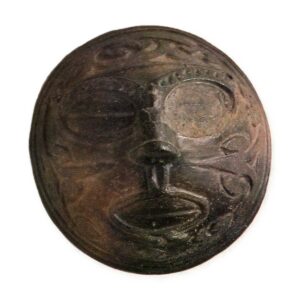
Also called mask. A Jomon-period clay tablet that represents a face and is thought to have been used as a mask. They appeared in the Middle Jomon period and continued to be found in the Late Jomon period. It is distributed in the central and eastern parts of Japan, especially in the Tohoku region, but only a dozen or so examples have been found. Some of them are large enough to be worn as masks, but most are small and were probably applied to the forehead. Some have holes for eyes while others do not, and some have holes on both sides for string threading while others do not. Some have holes for eyes and some do not. The latter cannot be positively called masks. There are also clay products with ears and noses made separately. These are thought to be partial products attached to the main body of the mask made of wood or leather. The history of masks dates back to the Paleolithic period, and there are two types of masks: those used for magical purposes and those made as death masks. Jomon period clay masks belong to the former category. In the world of earthly customs, there are known cases in which shamans, who are engaged in possession of gods and witchcraft, suffer epileptic seizures and mental derangement. In this connection, some Jomon-era clay masks with weeping, contorted faces and bent noses have been interpreted as epileptic images that capture the moment of facial nerve spasms (Esaka Teruya, “Clay Masks for Epilepsy”). (Teruya Esaka, “Clay Masks,” Isamu Kono, “Life and Art in the Prehistoric Period,” Japanese Primitive Art, 2)



